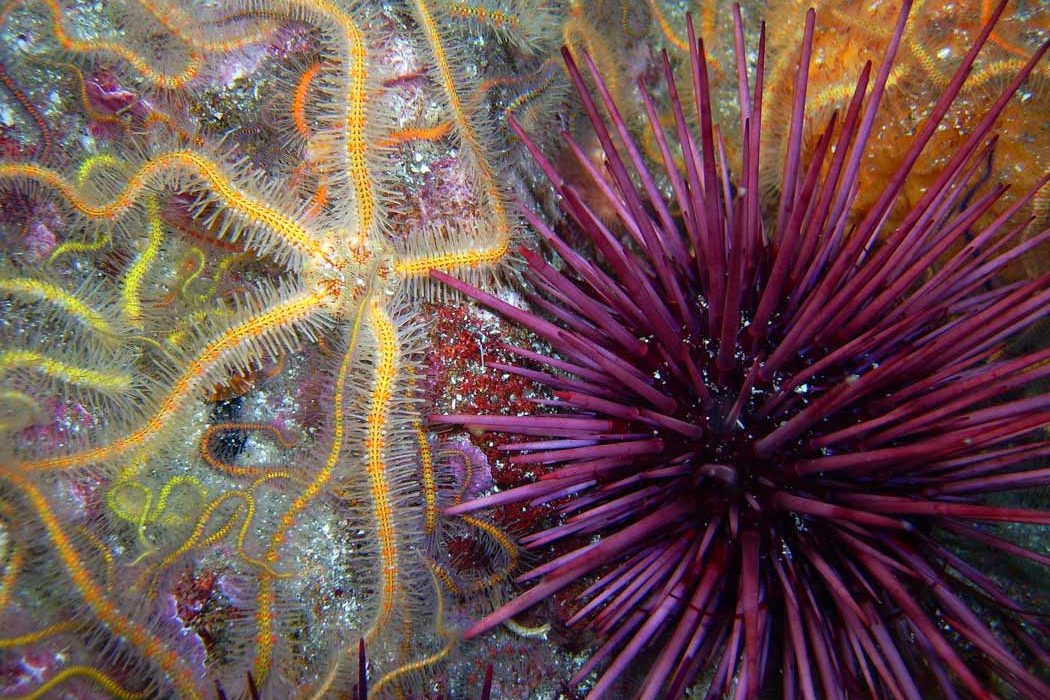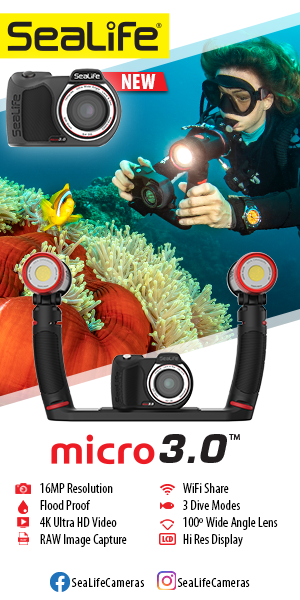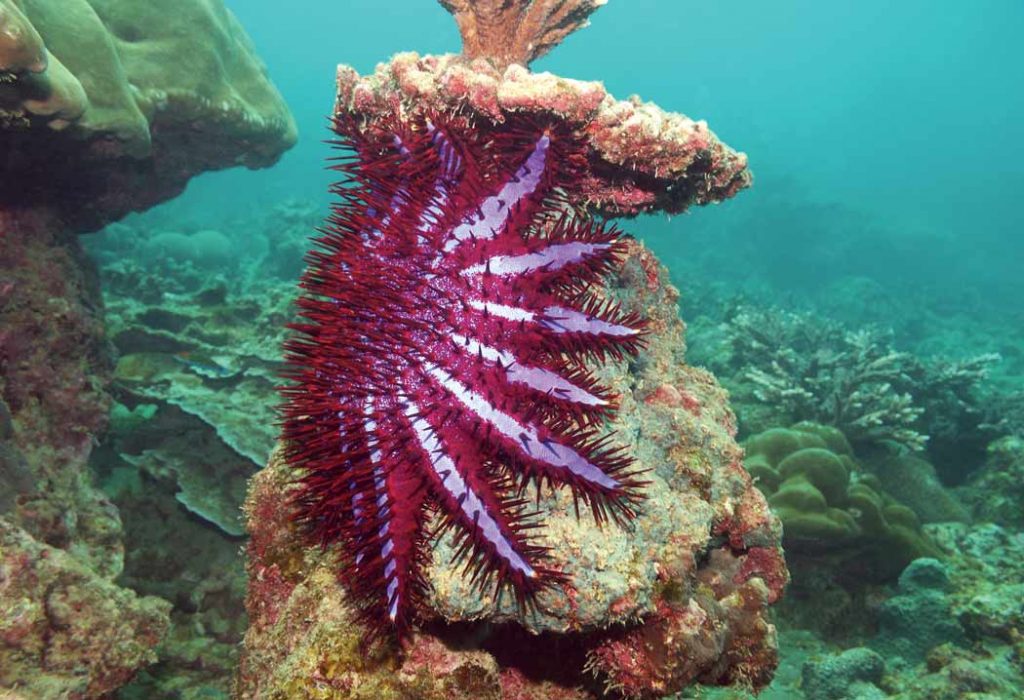Phylum: Echinodermata (spiny-skin)
Whether you are a newly certified diver (if so, we offer our congratulations) or an old salt (good for you, too), odds are you are familiar with the animals known as echinoderms. Of course, you might not realize it because most of us use other names when referring to the animals described in the phylum Echinodermata (ik I NO DERM at uh). We use names such as sea star, sea cucumber, sea urchin and sand dollar. So your familiarity with the members of this phylum might range from the joy of first learning about sand dollars to the pain of getting punctured by a sea urchin. In between you probably have marveled at the beauty of a brightly colored crinoid or feeding basket star and made a questioning face upon seeing a sea cucumber.
If you are like a lot of people, you recognize many of these animals but don’t realize that they are closely related to one another and to brittle stars, crinoids (also known as feather stars and sea lilies) and basket stars. Well, live and keep on learning. A good diver always does.
An ancient group of marine animals, echinoderms are very well-known from fossil records. Today, there are about 6,000 living species and all are bottom dwelling, or benthic, animals that live in saltwater ecosystems. Most echinoderms occur in temperate seas, but the phylum is represented in tropical and polar seas, too.
The Big Picture
The word “echinoderm”(ik I NO DERM) is derived from the Greek “echinos,” meaning spiny, and “derma,” meaning skin. The skin of most species is covered by spines, “warts,” or other projections. When first seeing an echinoderm, most people think that the skin is tough because in many species the skin looks tough. However, like books, you don’t want to judge an echinoderm by its cover, as the skin in many species is surprisingly delicate.
To many people, echinoderms look like relatively simple animals, and it comes as a bit of a surprise to discover just how sophisticated they are. The skin of echinoderms is filled with thousands of nerves. The skin and the nervous system help protect the internal skeleton, which in many species consists of calcium-impregnated plates. As the animal grows, the plates expand to support and shape the body. The spines found in many species are attached to those plates. The bodies of some species are covered by tiny, pincer-like organs called pedicellariae (ped-uh-sell-air-ee-uh) which are used in defense and to help echinoderms clean their own skin. Anyone who has ever committed the “no-no” of picking up a sea star is probably familiar with these organs. The small pincers are quick to grab on, and their numbers and tenacity make it difficult to let go of the animal without hurting it. One more reason not to handle or harass marine life.
Other prominent characteristics found in echinoderms are five-part radial symmetry, distinct organs, including tube feet and the absence of a true brain. Obvious five-part radial symmetry is easily observed in most sea stars but you need to examine the internal body structure of creatures like sea cucumbers and crinoids to see the symmetry, or be willing to accept some statements on good faith.
Even though the nervous system of echinoderms is built from several simple nerve rings that lack a “central command headquarters,” members of the phylum are capable of some surprisingly complex response patterns. For example, echinoderms crawl around on the substrate on thousands of small tube feet which are part of a body known as a water-vascular system. Allowing purposeful movement, the system is well-coordinated, but slow.
When echinoderms move in a manner such as walking or crawling, they pump sea water through a series of internal body canals. The water is used to inflate some of the tube feet, causing them to expand. In many species, the tube feet are equipped with suckers that grip onto the sea floor. The feet hold tight to the bottom as muscles within the feet contract, enabling the animal to propel itself. Repeating this process allows echinoderms to travel in a fashion that is “more turtle than hare.”
One of the most remarkable traits about echinoderms is their ability to regenerate body parts that have been lost. Many tropical destinations have learned this lesson the hard way. A sea star known as the wnwn of thorns readily preys upon living corals, and a crown of thorns invasion poses a serious, but usually temporary threat, to coral reef ecosystems. A few decades ago, when crown of thorns showed up in big numbers, resort owners asked local divers to go into the water and chop them up. Bad idea. Like many sea stars and brittle stars, crown of thorns not only regenerated lost parts, but in some instances the lost part often regenerated an entirely new animal. The not-surprising lesson here, “Don’t mess around with Mother Nature.” The ability to regenerate is an important part of the survival strategy of many species as they readily sacrifice body parts to escape predation.
Sexes are separate in most echinoderms, but they look very similar and distinguishing male from female is a task best left to specialists. Reproduction is most often achieved by spawning as males and females simultaneously release sperm and eggs into the water column where sexual union occurs. The resulting larval life-forms spend from a few days to a few weeks as part of the community of plankton before settling down to live their adult lives on the sea floor.
Amazingly, some echinoderms can reproduce asexually on a regular basis. These “sexperts” break in two and regenerate into two animals.
Five Classes
Within their phylum, modern day echinoderms are described in five classes. They are listed below.
Crinoidea (crinoids and sea lilies). [cry NOID E uh] Different species of crinoids possess anywhere from five to 200 arms. When first developing, crinoids have only a few arms, but some species develop more as they grow. The arms of many species are branched into small structures known as pinnules. Crinoids are suspension feeders; while they lack a truly organized “filter,” they collect plankton and dead organic matter from the water column.
Asteroidea (sea stars). [Aster OID E uh] Though there are some notable exceptions, the pentamerous symmetry of sea stars is usually obvious. They possess five arms. The arms of sea stars are not as sharply set off from the body center as are those of brittle stars. Some sea stars are scavenger and predator, while others are one or the other.
Ophiuroidea (brittle stars). [O FE yur OID E uh] Brittle stars possess long, thin, fragile arms set off sharply from the center of the body, which is known as a central disc. In most species the arms fall off easily when the animal is under attack. Members of this class include a variety of suspension feeders and species known as detritovores that feed on dead and decaying matter, and predators.
Holothuridae (sea cucumbers). [hollow THUR id ay] Sea cucumbers possess cylindrically shaped, pliable bodies. The characteristic of radial symmetry is only obvious in a cross-sectional view. Some sea cucumbers are sediment ingestors, some feed on detritus and others are suspension-feeders. When threatened, many sea cucumbers are able to expel their innards, an escape strategy which repels many would-be predators.
Echinoidea (sea urchins and sand dollars). [ech in OID E uh] Most members of this class (known as echinoids) have bodies that are flat and disc-shaped or round with spines. Most species are herbivores and sediment ingestors.
Now, let’s take a closer look at each class…
Crinoids
Crinoids are considered among the most ancient of all marine creatures. When they appeared in the world’s oceans eons ago, crinoids were attached to the sea floor via large stalks. Ancient crinoids are also known as “sea lilies.” To feed, these organisms reached up into the plankton-rich water column to capture their prey. Many believe that crinoids needed more mobility to compete for and catch their prey, and to escape predation. As a result, most lost their stalks and eventually developed numerous, shorter claw-like “legs” known as cirri (also cirripedia) which offer greatly increased mobility and enable the animals to grip the sea floor. Modern-day crinoids, also called feather stars, tend to “walk” along the bottom, but at times you will see them “swimming” through the water in a slow, graceful, undulating motion.
A few species of stalked crinoids have survived, and scientists jokingly call them “living fossils.” Stalked crinoids are rare and live in water that is deeper than sport divers explore. However, you will likely see a stalked crinoid or two if you go on one of the deeper submarine rides offered in Grand Cayman.
Modern-day crinoids occur in oceans around the world, and they do so with eye-catching style and color. Crinoids occur in brilliant colors from bright-daisy yellow to gold, green, bright red, white, black and all kinds of color combinations. All are feather-like as the arms of these delicate creatures project out from their perch like the plume of a peacock. When feeding, which is at night in most instances, many species look like a basket made of long, colorful, feathered branches.
In daylight, divers often see only the ends of the delicate, feathery arms reaching out of a crevice. But at night, especially in tropical seas, crinoids can be seen perched high atop sea fans and coral heads where their arms can easily reach into food-bearing currents. Crinoids are known as suspension-feeders. They reach into the water column and, using their tube feet, capture their prey of small planktonic organisms.
The arms of feather stars are branched into numerous small structures called pinnules, and each pinnule contains numerous small feet. Pinnules are also covered with sticky secretions which trap food that is then grabbed by the tube feet. At that point the arm is curled inward toward the animal’s mouth.
Many crinoids are stunning. It is quite tempting to reach out and touch them. Please don’t. They are far more delicate than they appear, and their arms are quick to fall off even if only gently handled.
Sea Stars
Depending upon your age, you probably know the group of animals correctly called sea stars either as starfish or sea stars. I have to confess that these animals were starfishes when I was a kid. Obviously, they are not fish, so a name change was generally agreed upon in educational circles to try to prevent confusion. But no matter what name you use, colorful sea stars add a lot of interest to many dives. Worldwide, there are about 1,500 species of sea stars. Most occur in tropical and temperate seas where they serve important roles as marine predators. Of the sea stars found in the tropics, most occur in the Indo-Pacific, but several species play important environmental roles in the waters surrounding Florida, the Bahamas and the island nations of the Caribbean.
The arms (sometimes called rays) of sea stars are much thicker and more prominent than those of brittle stars. Most species possess five arms, but members of some sea star families have many more. The giant sunflower star, which occurs along the Pacific coast of the western Americas, is a well-known example of a many-armed sea star.
The mouth of sea stars is on the underside of the central disc. Neatly arranged rows of tube feet can be found on the underside of each arm. The mouth of some echinoderms such as crinoids is on the upper surface of the body, but sea stars find their food on the sea floor and having a mouth on the bottom surface has its advantages for bottom feeders.
Sea stars prey on a variety of food sources. Some sea stars have developed the ability to prey upon a variety of bivalves (For more information, see “Mollusks,” Dive Training, June 2001.) These sea stars grasp the shells of the bivalves with the suckers on their tube feet and then … what happens next is still debated. Some specialists believe the sea stars pull the shells apart and then extrude their own stomachs through the shells of the bivalve and begin to digest their prey externally. Others maintain that the sea stars first tire the mollusk by holding the shells closed, and eventually this forces the bivalve to open its shells to access oxygenated water. Cooperative prey make it much easier for the sea star to get to the desired body parts. Those who argue against this theory are quick to point out that the shells of bivalves rarely close perfectly anyhow, so getting a fresh supply of oxygenated water is probably not impossible for bivalves. Most sea stars do not feed in this manner, but those that do can push their stomachs through an opening that is only .04 inches (10 cm) wide.
The species of sea star known as the crown of thorns is, perhaps, the most widely recognized sea star. Armed with long, thorn-like spikes, this species is well-known because of its voracious feeding habits and the manner in which hordes of crown of thorns are known to devastate corals reefs by preying upon the living corals.
Brittle Stars and Basket Stars
Even after learning that brittle stars and basket stars are echinoderms, you might not suspect that they are so closely related that they would be described in the same class. But their body design is quite similar and they are very closely related animals. Their bodies are made of a central disc that is distinctly separated from slender arms. But basket stars have many more arms than brittle stars, which usually have five.
Brittle stars and basket stars tend to be reclusive during the day, and unless you are an experienced diver and a skilled observer, you might think that the reef you are exploring during a day dive is not a place these animals call home. But visit the same reef at night, and you will think you must be at a different site as often there are brittle stars and basket stars everywhere you look.
In many temperate and tropical locales, brittle stars seem to occupy almost every conceivable nook and cranny. Many bury themselves in the sand and all you see during the day is what looks like a waving arm of some creature that must have been accidentally covered up. Others hide in crevices in the reef. In tropical seas, if you look in and around the base of sponges, you will likely find a bunch of scrunched up, hiding brittle stars. They shy away from light and are mostly seen at night. And even at night, if you do want to take a close look, it is often a good idea only to illuminate them with the peripheral beam of your dive light. If alarmed, most brittle stars are surprisingly agile and fast to seek cover.
Every once in a while, brittle star populations seem to explode in some areas and can be seen all over the place day and night. In fact, a few years ago, during the last El Niño event in southern California, we experienced an enormous brittle star explosion. Almost everywhere anyone dived, there were uncountable numbers of very colorful brittle stars, including on top of sea fans, urchins, sea stars and on the reef and sand.
The arms of brittle stars are lined with numerous spines that are arranged in rows, and they have several tube feet distributed along the rows. In some species, the dense concentration of spines gives the brittle stars a fuzzy appearance.
Brittle stars feed in a variety of ways. Some are suspension feeders, capturing plankton out of the water. Others sift through sand seeking organic debris, while others are predators that pursue a variety of small invertebrates and vertebrates.
Basket stars only have five arms. However, the arms are branched at the base so with many specimens it seems like they have dozens of arms. Of course, part of the reason is that the branches are branched, too. The repeated branching eventually makes a creature that looks like a large, somewhat tangled ball of yarn. That is the nonfeeding daytime look. When basket stars feed the ball of yarn unfurls and the arms extend to make a basket-like or net-like sieve that catches plankton and other organic matter that passes. Tube feet arranged in regular patterns along each of the arms help basket stars catch their food and pass the food particles to their mouth. When feeding, basket stars are usually perched at prominent outcroppings or in high places in a reef community, and often they are seen on sea fans.
Sea Cucumbers
Aptly named, sea cucumbers are the sluggish creatures that often cause new divers to ask, “What are those things on the sea floor that look like cucumbers?” They differ from other echinoderms in that they are more soft-bodied and their leathery skin lacks spines, but the skin of many species is covered with wart-like projections. Their five-sided radial symmetry is only obvious if you view a cross-section of an animal in a lab and see five, elongated, radial muscles. Interesting to know perhaps, but not the sort of thing most of us really want to do with our time.
In a word or two, sea cucumbers are the ocean’s vacuum cleaners. They use brush-like mouths to ingest organic matter from sediment on the sea floor. At one end of the sea cucumber’s sausage-shaped body is its mouth; at the other end, its anus. The mouth lacks teeth, but contains from eight to 30 mop-like tentacles that are used to trap prey and draw it into the mouth. In some species, the tentacles also secrete a mucus net that is used to trap prey. They are the long, whitish, stringy looking fibers that extend from crevices and look like they are connected to nothing. When feeding, each tentacle is periodically wiped off in the esophagus to remove food and to replace the mucus coating. As they feed and move along the sea floor, sea cucumbers often leave neat rows of excreted inorganic deposits behind them.
A relatively small (thank goodness) species of fish known as a pearl fish actually lives in the bodies of sea cucumbers, exiting and entering at will through the cucumber’s anus.
When threatened, some sea cucumbers can eviscerate or expel their own stomachs in an effort to repel or distract predators. That’s a small price to pay to escape predation, especially when they can regenerate a new stomach within a matter of days. When relaxed, the bodies of sea cucumbers are flexible and elongate, but when threatened or disturbed they are able to shorten and harden their bodies.
Some species have tube feet scattered around a rather uniform looking body, while in other species the feet are distributed only in five lateral grooves. Some species have one body surface that is slightly flattened, and all of the tube feet are on that flattened side.
Sea cucumbers are highly valued as a food source in many parts of the Far East, and commercial fishing industries pose serious threats to sea cucumber populations in many parts of the world as the catch from these fisheries is primarily shipped to markets in the Orient.
Sea Urchins and Sand Dollars
This class of echinoderms is somewhat of a dichotomy. Most divers probably get warm, fuzzy feelings when we think about sand dollars and the places where we first saw them as kids. But say the term “sea urchin” to scuba divers and most think of them as #@!!%! painful pin cushions. Few marine organisms have inflicted as much pain, grief and misery on divers, snorkelers and even beachgoers as sea urchins have with their needle-like spines. If you closely examine the spines, perhaps even under a microscope, you will see that the spines are armed with several fishhook-like barbs that help the spines penetrate easily but make them difficult to remove. So while we tend to think of these creatures in very different lights, scientists know them as very closely related animals.
The bodies of sea urchins and sand dollars display five-part symmetry, and members of each group possess five rows of rather neatly arranged tube feet that protrude through hard, calcified plates. The fused plates can easily be seen when you look at the “skeleton” or test, as it is more properly known. The spines of some urchins, such as the long-spined urchin found in the Caribbean and some close Indo-Pacific cousins, are needle-sharp and can be 12-14 inches long, or longer. The spines of purple sea urchins and black sea urchins found in reefs of southern California are not as long or as sharp, but they, too, are painful and should be avoided.
Despite what divers injured by sea urchins might think, the spines are primarily used to ward off predators that would like to get to the meat inside the urchin’s test. Cleverly, some small fishes ranging from a variety of gobies to juvenile seabasses use the forest of spines as a perfect place to hide from potential predators. Some shrimps also associate with sea urchins.
Fortunately, most species of long-spined sea urchins tend to occupy crevices during the day, and emerge at night to feed.
The spines of a variety of other species are less than 1 inch long and in some animals appear to be missing, or impotent. Many of these urchins cover their bodies with organic debris and rocks for added protection. Some of these species are poisonous to handle.
Many urchins are voracious feeders and they prey heavily on a variety of algae, including giant kelp. In turn, urchins are heavily preyed upon by a variety of fishes and sea otters. It is normal to see a fish such as a California sheephead or a queen triggerfish in Caribbean waters swimming around with a sea urchin spine or two stuck into its head. Again, there is no such thing as a free lunch. With the removal of otters because of overhunting in California, sea urchin populations occasionally expand rapidly and that often means that the urchins annihilate kelp forests.
In contrast to other echinoderms, sand dollars have flat, disc-shaped bodies. But if you closely compare their bodies with those of sea urchins, several common characteristics soon become obvious. Both groups walk across the sea floor using tube feet, though some urchins gain additional thrust by using their spines. It is quite common to find hundreds of sand dollars within moments of discovering a single specimen.
Story by Marty Snyderman







